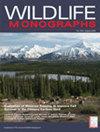控制对阿拉斯加内陆邻近受保护狼种群动态的影响
摘要
长期的狼(Canis lupus)研究项目提供了许多关于狼种群动态的见解。随着狼的管理变得越来越密集,了解控制狼种群对密度、环境条件和人为死亡率变化的反应机制非常重要。与人类争夺有蹄类猎物的竞争导致了大规模的狼控制计划,特别是在阿拉斯加,尽管狼的种群数量可能维持相对较高的常规收获率(例如22-29%),但控制计划的设计是为了在种群水平上产生持久的影响。了解狼控制工作对周边地区的更广泛影响是美国国家公园管理局等保护机构特别关心的问题,它们的任务通常排除人为减少本地捕食者的数量,特别是为了增加可供人类收获的猎物生物量。在控制努力的背景下,对影响种群活力率(即生存、出生、扩散)和种群轨迹的因素进行详细评估,对于理解狼与其猎物之间复杂的生态关系并为各自的管理提供信息至关重要。利用长期数据集和强大的新型综合建模方法,我们评估了狼控制对主要居住在禁止狼控制活动的邻近保护区内的监测狼种群动态的影响。本文对美国阿拉斯加州育空-查理河国家自然保护区(YUCH)狼种群动态进行了22年(1993-2014)的监测。在我们的研究中,在周边地区实施了2个大规模的狼控制计划,主要目标是增加40英里驯鹿群的规模。我们使用了已知命运的数据,这些数据是基于有标记的狼的迁移和相关狼群同伴的重复计数来估计生存、分散和死亡率。我们使用综合建模方法对这些数据进行了联合分析,从而使用YUCH对整个居住的狼群种群进行了推断。在致命控制期间,研究区域的表观存活率(即包括死亡率和分散)较低,表明尽管禁止在育成区内进行控制,但控制的直接加性效应仍然存在。在降雪量高于平均水平的冬季之后的几年里,表观存活率更高,这与次年有蹄动物猎物脆弱性的预测增加相对应。域外攻击与较低的表观存活率相关,特别是在周围地区开始致命狼控制之后。总的来说,全年的死亡率趋于均匀,而在冬末和早春期间,分散率增加。在我们所有年龄段(不包括已知的繁殖者)的有圈样本中,分散约占观察到的损失的一半,尽管一岁的幼崽最有可能分散。在这两个狼群控制项目中,狼密度持续下降也使我们能够直接评估密度降低对生命率的影响。在每个控制项目的过程中,狼的出生率(5 - 8月间每个狼群增加的估计个体数量)急剧增加,表明对周围地区狼密度的大规模减少有强烈的繁殖反应。两个控制项目之间的出生率迅速下降,进一步支持了这一结论。在接下来的一年里,较小的族群规模和已知繁殖者的减少与较低的族群出生率有关,这表明人类造成的死亡可能会通过减少族群规模和移除繁殖者而对生产力产生直接的短期影响。然而,尽管控制可以在短期内降低单个狼群的繁殖力,邻近种群通过提高出生率迅速对狼密度的减少做出反应。基于狼群中有标记个体迁移的狼密度估计依赖于样本量,不能可靠地估计种群增长率(λ)。作为替代方案,我们开发了一个新的度量,λ*,在假设狼种群的最小功能单位是一对繁殖对的情况下,评估出生是否足以抵消每年的种群损失。当λ*由于个体的丧失和群体的解散而降低到1.0以下时,目标种群有效地成为依赖周边地区移民维持的种群下沉。 根据λ*的估计,我们确定在实施致命狼控制之前的大多数年份,YUCH研究种群是周边地区狼的来源,但在实施致命狼控制之后,尽管禁止在YUCH内进行控制活动,但仍成为主要依赖周边地区移民的种群汇。这一发现对保护区的管理具有重要意义,特别是在阿拉斯加等地区,狼的控制通常在大的空间尺度上实施。我们期望λ*也能成为了解狼生态和管理其他地区种群的有用工具。总体而言,狼的生命率是动态的,对变化的条件反应迅速。在种群密度下降的情况下,狼的出生率迅速上升,这表明密度依赖性在调节狼的种群数量中起着重要作用。在分散和死亡率上的灵活性可能使狼种群对猎物资源、狼密度和死亡率的变化做出反应。这些发现还表明,可持续收获率取决于种群活力率的年度变化。管理方案在尤大附近地区的明显影响表明,有效保护保护区可能需要比通常采用的更积极的管理决策,特别是如果维持不变的系统动态是一个主要目标。©2017年出版。这篇文章是美国政府的作品,在美国属于公有领域。Wiley期刊公司代表野生动物协会出版的野生动物专著。Long-term wolf (Canis lupus) research programs have provided many insights into wolf population dynamics. Understanding the mechanisms controlling responses of wolf populations to changes in density, environmental conditions, and human-caused mortality are important as wolf management becomes increasingly intensive. Competition with humans for ungulate prey has led to large-scale wolf control programs, particularly in Alaska, and although wolf populations may sustain relatively high (e.g., 22–29%) rates of conventional harvest, control programs are specifically designed to have lasting population-level effects.
Understanding the broader impacts of wolf control efforts on the surrounding area is of particular concern for conservation agencies such as the United States National Park Service, whose mandates generally preclude the artificial reduction of populations of native predators, particularly for the primary purpose of increasing available prey biomass for human harvest. Detailed assessments of the factors influencing population vital rates (i.e., survival, natality, dispersal) and population trajectory in the context of control efforts are critical for understanding complex ecological relationships between wolves and their prey and informing management of each. Using a long-term dataset and a powerful new integrated modeling approach, we assessed the effects of wolf control on the dynamics of a monitored wolf population residing primarily within an adjacent protected area where wolf control activities were prohibited.
We monitored wolf population dynamics in Yukon-Charley Rivers National Preserve (YUCH) in interior Alaska, USA for 22 years (1993–2014). During our study, 2 large-scale wolf control programs were implemented in the surrounding area with the primary goal of increasing the size of the Fortymile caribou herd. We used known-fate data based on relocations of marked wolves and repeated counts of associated pack mates to estimate survival, dispersal, and natality rates. We jointly analyzed these data using an integrated modeling approach, thereby providing inference to the entire resident, pack-dwelling population of wolves using YUCH. Apparent survival (i.e., including mortalities and dispersals) was lower in the study area during the lethal control period, indicating a direct additive effect of control despite the prohibition of control efforts inside YUCH boundaries. Apparent survival was higher in years following winters with above-average snowfall, corresponding with a predicted increase in ungulate prey vulnerability the following year. Extraterritorial forays were associated with lower apparent survival rates, particularly after the initiation of lethal wolf control in the surrounding area. In general, mortalities tended to occur evenly throughout the year, whereas dispersal rates increased during late winter and early spring. Dispersals accounted for approximately half of the observed losses in our collared sample across all age classes (excluding known breeders), although yearlings were the most likely to disperse.
Sustained reductions in wolf densities outside the YUCH boundary during both wolf control programs also allowed us to directly assess the effects of reduced density on vital rates. Natality rates (estimated number of individuals added to each pack over the May–Aug interval) increased sharply over the course of each control program, suggesting a strong reproductive response to large-scale reductions in wolf densities in the surrounding area. Natality rates dropped rapidly between the 2 control programs, further supporting this conclusion. Smaller pack sizes and losses of known breeders were associated with lower natality rates per pack in the following year, suggesting human-caused mortality could have direct short-term effects on productivity by reducing pack sizes and removing breeders. However, although control can reduce the fecundity of individual packs in the short term, adjacent populations quickly respond to reduced wolf density by increasing natality rates.
Estimates of wolf density based on relocations of marked individuals within packs were dependent on sample size and could not be used to reliably estimate population growth rate (λ). As an alternative, we developed a new metric, λ*, which assessed whether natality was sufficient to offset population losses on an annual basis, under the assumption that the minimum functional unit in a wolf population is a breeding pair. When λ* decreased below 1.0 because of a combination of loss of individuals and the dissolution of packs, the population of interest effectively became a population sink reliant on immigrants from surrounding areas for maintenance. Based on estimates of λ*, we determined the YUCH study population was a source of wolves for the surrounding area in most years before implementation of lethal wolf control but became a population sink largely reliant on immigration from surrounding areas afterwards, despite the prohibition on control activities within YUCH. This finding has important implications for the management of protected areas, particularly in areas such as Alaska where wolf control is commonly implemented at large spatial scales. We expect λ* will be a useful tool for understanding wolf ecology and managing populations in other areas as well.
Overall, wolf vital rates were quite dynamic and responded quickly to changing conditions. The rapid increase in natality in an apparent response to decreased density strongly suggests that density dependence plays an important role in regulating wolf populations. Flexibility in dispersal and natality rates likely allow wolf populations to respond to variation in prey resources, wolf density, and mortality. These findings also suggest that sustainable harvest rates depend on annual variation in population vital rates. The clear impacts of management schemes in the area adjacent to YUCH suggests that effective conservation of protected areas may require more active management decisions than are often employed, particularly if the maintenance of unaltered system dynamics is a primary objective. © Published 2017. This article is a U.S. Government work and is in the public domain in the USA. Wildlife Monographs published by Wiley Periodicals, Inc. on behalf of The Wildlife Society.

 求助内容:
求助内容: 应助结果提醒方式:
应助结果提醒方式:


